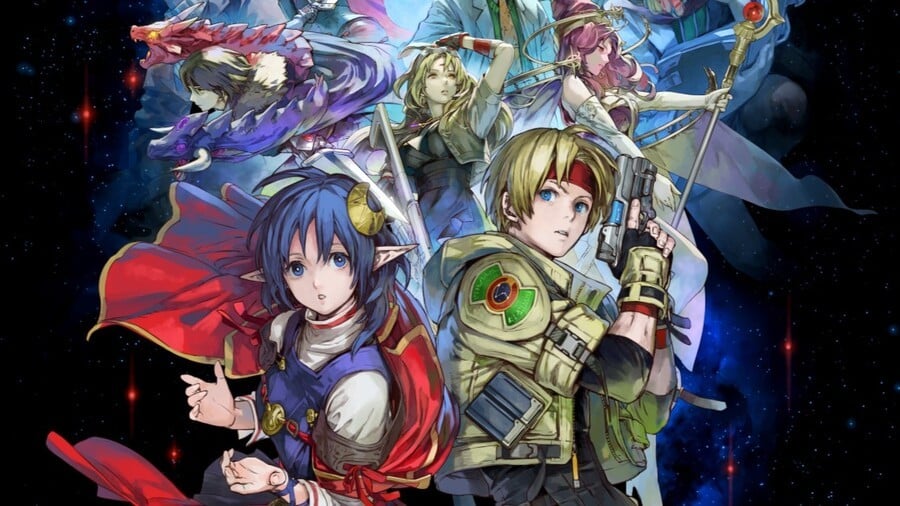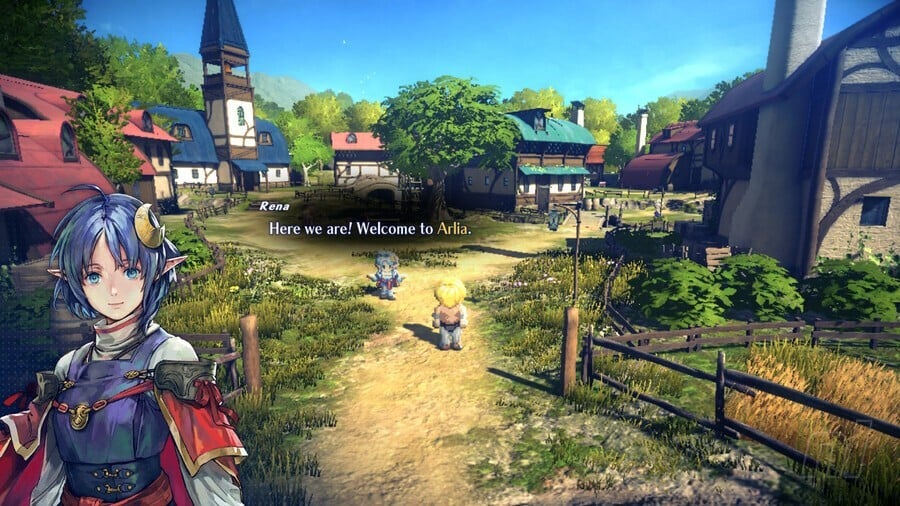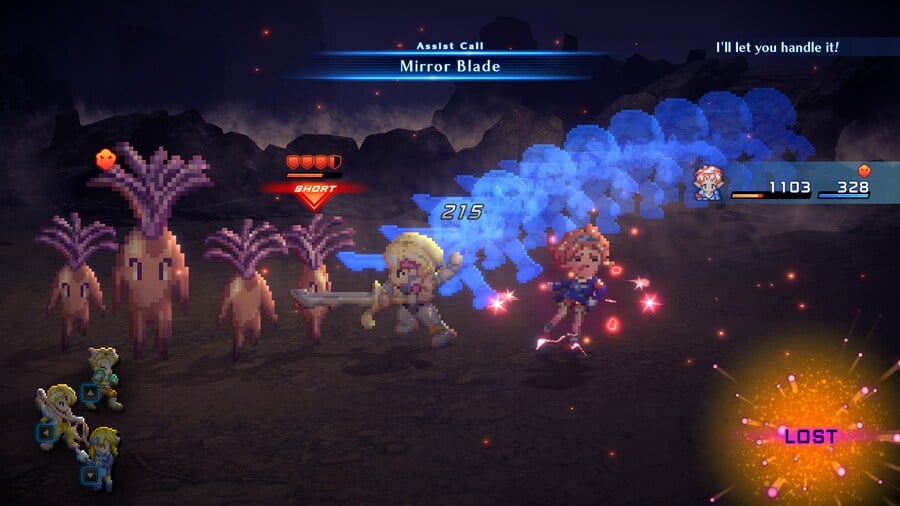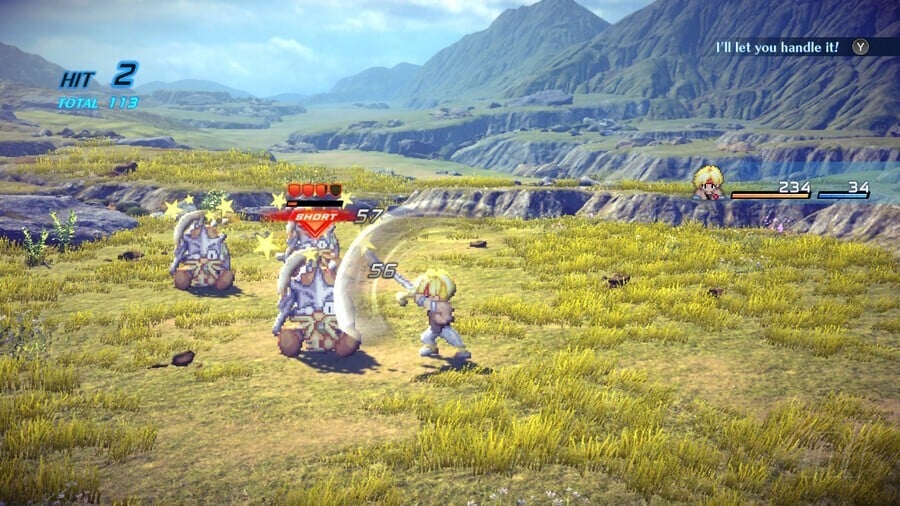
Saying that the original PlayStation was a treasure trove of RPGs is a bit of an understatement. But even with that statement, Star Ocean: The Second Story remains a standout to many RPG fans. Its blend of sci-fi and classic fantasy, action combat, and crunchy synth tunes hit a particular chord back in the late ‘90s. This was the West’s first exposure to the Star Ocean series – and for many, the series has never reached those highs from 1998.
But Star Ocean is a series that started way back on the Super Famicom. Despite its Nintendo origins, Star Ocean has often remained adrift from Nintendo platforms. 2001’s Blue Sphere – a Game Boy Color spin-off and sequel to The Second Story – and Star Ocean: First Departure R, a remaster of a PSP title, remain the only two other games in the series to release on a Nintendo console.
The original PlayStation title is probably the most popular entry in the venerable series, and that explains why Star Ocean: The Second Story R's initial reveal was so well received. This is a remake of a PlayStation favourite, and it launches on 2nd November 2023, just months after the game’s 25th anniversary in Japan (30th July, 1998). There’s no better time to release a remake in our mind, and that’s what the developers seem to think, too.

“We received a request from Square Enix to do something memorable” Gemdrops CEO and director and producer of the remake Yuichiro Kitao told us in a recent video call. “With the release of Star Ocean 6 [The Divine Force] last year, we were able to get newcomers into the series, but we also wanted them to understand what the Star Ocean series is.”
Kitao-san was joined by Motoi Sakuraba, the series’ composer, who says that the series “means a lot” to him. It’s clear that this remake is one built from passion – to give the fans what they want, but also reintroduce a classic to the world and make it more accessible.
A Sea of Stars
With the release of Star Ocean 6 last year, we were able to get newcomers into the series, but we also wanted them to understand what the Star Ocean series is.”
The series’ history is important to understanding just why The Second Story is held in high regard among RPG fans. Star Ocean on the Super Famicom is notable for being tri-Ace’s very first video game. The studio was formed by former Wolf Team staff who worked on another franchise-starting action RPG on the Super Famicom – Tales of Phantasia – and similarly, the game broke many visual and audio boundaries. Its intensive visuals demanded the use of a special compression chip, the S-DD1, plus it used voice acting and real-time combat (or as real-time as the Super Famicom could handle).
The original Super Famicom game never came out in the West because Enix America stopped publishing games in 1995 due to poor sales. Instead, anyone who wanted to try the first Star Ocean game had to do so via emulation and a fan translation from DeJap Translations, who also created the popular fan translation for Tales of Phantasia. We’d have to wait until the PSP remake to get an official taste of the series’ origins.

What makes Star Ocean so unique compared to many other RPG franchises is how it handles characters and character interactions. Private Actions are additional scenes that allow you to spend more time with supporting characters in your party, and build up an affection meter that can affect the endings. For the earlier titles in the series, depending on the choices you make and the characters you recruit to your party, you may be locked out of having certain characters in your playthrough, or you may have to recruit them much later. A completionist's nightmare for sure, but it makes choices and actions feel consequential and encourages multiple playthroughs.
All of this was present in Star Ocean: The Second Story on PlayStation, which ended up being most people’s introduction to the series. A pretty in-depth crafting system was added – which ends up being vital to getting through the later portions of the game – and you had the option of choosing between two protagonists: Claude C. Kenny, an Ensign of the Pangalactic Federation and son of Ronyx J. Kenny from the first game, and Rena Lanford, a young girl who lives on the underdeveloped planet of Expel.
What is a JRPG?
Star Ocean: The Second Story R takes the beloved classic and turns it into something that feels both nostalgic and new. It’s not a port or rerelease of the PSP remake Star Ocean: Second Evolution in the same way that Star Ocean: First Departure R was for the first entry. It retains the essence of the original pixel-art action RPG while making modern improvements to the visuals and gameplay – but not enough to stray from its roots.
We asked Kitao about what kind of experience he brought to the table for this remake, having worked as battle programmer on Star Ocean: Till the End of Time and program manager on I Am Setsuna, two very different RPGs. “When we developed this game, we looked at a lot of different qualities that fans and players liked about JRPGs,” he told us. “When you say JRPG, they’re not all the same game. There’s a JRPG game that has real-time combat, but there's also JRPG games that have command-based or turn-based combat too. So JRPG isn't all just one blanket kind of game, if that makes sense.”
It’s an interesting conversation to have months after Final Fantasy XIV director and producer and Final Fantasy XVI producer Naoki Yoshida's thoughts on the JRPG term. To Kitao, JRPG isn’t just one thing, nor is it about where the games are made – it’s a multitude of different things, which Star Ocean: The Second Story R slots into but also borrows from, in multiple different ways. Kitao’s experience working on other RPGs helped him understand how to approach reintroducing Star Ocean: The Second Story to the world. It wasn’t just about bringing back a classic – it was about respecting the genre and taking "advantage of our past experiences with the developments of numerous JRPG titles."
JRPG isn't all just one blanket kind of game, if that makes sense.
Having spent some time with the demo – which dropped on Switch shortly after the September 2023 Nintendo Direct – we can feel the history and experience that has gone into this remake. If you’ve played the original PlayStation version, you’ll slip right into The Second Story R, but you’ll notice those minor changes and details that make the game feel smoother. There’s still a world map, but now enemy encounters appear on the map rather than being random, and visually, the blend of pixel art and 3D backgrounds – not quite pre-rendered but they feel pre-rendered – is gorgeous, particularly on an OLED model Switch.
A Second Evolution
“We looked at a lot of different genres or sub-genres from these RPG games and implemented a lot of the good parts of the two different kinds of combat, so like the real-time combat and the turn-based combat,” Kitao told us, again using that experience from working on Resonance of Fate (lead programmer), CRYSTAR (director), and even Valkyrie Profile (battle programmer). No two RPGs that Kitao has worked on have quite been the same, and that shows here.

The combat in The Second Story R isn’t that different from the original PlayStation release, or even from Star Ocean: First Departure R. It’s an action RPG where you control one character in real-time while the other three are controlled by AI, determined by tactics which you can assign in the menu. You can hop into a menu to use items and pause flow if needed, but otherwise, the 3D space is yours to run around in.
In the remake, there are a few new bells and whistles that help make combat feel snappier than it was on the PlayStation. We got that sense almost immediately, and simply running around and fighting enemies on the world map was a joy. Skills seem to proc much faster, and movement feels much smoother. But some of the new additions certainly help with that.
For one, there’s now a backstep which you can use to avoid enemy attacks, counter, and regain MP – similar to side steps and backsteps in later Star Ocean titles. You can also stun an enemy by breaking their shield, which will give you an opportunity to unleash tons of damage.
We were able to come up with this new system of achievements [in the remake] and also retain the better parts – the fun parts – of the achievement system in Star Ocean 3.
Battle Trophies have also been added to Second Story R, another feature that’s present in later Star Ocean games. This is an achievement system that was introduced in Til the End of Time, rewarding you with little trophy items for completing challenges. Sometimes you’d need to beat a boss within a certain time limit, while other times you're required to kill an enemy with a specific skill.
“There are various ways to get involved, not just in battle, but with things that the player does on the field, too. We were able to come up with this new system of achievements [in the remake] and also retain the better parts – the fun parts – of the achievement system in Star Ocean 3.”
This fusion between the past of the series and the present feels like a really lovely way to acknowledge the franchise’s successes and use them to retroactively enhance and refresh an older experience. It also provides an easy segue for those who have only played later entries. It bleeds through every single asset of the remake, right down to the music, where series composer Sakuraba returns once again.
Space Operatics
Sakuraba is a veteran composer in the RPG genre, having worked on the Tales of series, Baten Kaitos, Valkyrie Profile, Dark Souls, and Golden Sun soundtracks (among many, many others). But his work on the original Star Ocean: The Second Story remains a favourite.
But rather than just remastering the music from the original PlayStation release, or even just reusing it (though the original songs are included and you can swap between them at any point), Sakuraba has rearranged the entire iconic soundtrack.
“We tried to make sure that the song's taste was not broken”, Sakuraba told us. “The main focus was to add new elements to the compositions while retaining the core concepts that were established back then. In terms of my approach to the composition process, I ensured not to alter the vibes of the original tracks.”

We were actually shocked when hearing the music in the demo, stunned at how different yet familiar these iconic tracks sounded. ‘The venerable forest’, a predominantly flute and synth track in the original game, now sends chills down our spines with beautiful violins, a choir, and plucked string instruments. It’s rather different, but it is still very much the same song. The same can be said for the game’s iconic battle track, ‘Stab the sword of justice’, an energetic synth track that always pumped us up before battle. The Second Story R’s version is all eclectic guitar, violin, viola, and heavy drums, which Sakuraba was keen to include with these now-live orchestra rearrangements.
On the topic of that live orchestra, Sakuraba says that he “wanted to make sure that the original qualities were being kept in these new arrangements,” while also considering that “for newer players, they might feel like some things may be lacking if they hear the original track as is, or if they hear something that closely resembles the original tracks too much.”
I ensured not to alter the vibes of the original tracks
It’s an update to an old sound that is unmistakable but fresh, faithful but modernised, and Sakuraba used modern-day tech and instruments to create that feeling of nostalgia. “We added live strings and drums. This was a technology that was impossible when Star Ocean 2 was released, but is now possible.” It’s more synth-y than a modern retro-style RPG like Square Enix’s Octopath Traveler, but it evokes that same cosy, old-school feeling.
Pitch (and Pixel) Perfect
The new arrangements pair nicely with the game’s new visual style. At the time of the game’s reveal, many (including us) compared it to Octopath's HD-2D style, with the mix of pixel art characters, 3D backgrounds, and strong lighting. And it turns out, even with a remake, the new visual style is crucial to shaping the music.
“When I write music, I make sure the music is in sync with the frame rate, the overall movement of the video,” Sakuraba says. “So I also have the team share the cutscenes with me prior to composing these tracks and I go by the frame rate of these cutscenes and make sure that the tracks are aligned frame by frame with the overall structure of the footage.” It’s a fascinating approach to composing music for a video game – particularly a 25-year-old title which is being remade in a pixel art style. It feels old school, which is perhaps why it works so well and feels so good when playing the demo.
From the three-hour demo alone, Star Ocean: The Second Story R looks and feels like one of the purest remakes we’ve experienced. It respects the source material by embracing the original art style, yet modernising it just enough. It rebalances the game to make it more accessible for newcomers, but also more rewarding and challenging for returning fans.
What impresses us most about Star Ocean: The Second Story R, at least those initial three hours, is how it respects not only the franchise's history and what followed the original PlayStation game but how it manages to deftly balance the old and the new to appeal to both sides of the galaxy. The dialogue is a little cheesy (the voices and script are the same as the PSP release), and it starts off similarly to any old-school-style RPG. But in the same way as the culture clashes of the Star Ocean games – futuristic technology meeting with underdeveloped (medieval-style) planets – it all comes together to create a fascinating remake, one that we can’t wait to see through to the end.
This interview has been edited lightly for clarity.
Thank you to Kitao-san, Sakuraba-san, Square Enix, and Gemdrops for making the time to speak to us. Star Ocean: The Second Story R launches on Switch and other platforms on 2nd November 2023.
You can download a free demo — which allows you to play the first three hours and carry over your save data to the full game — right now on Switch eShop.





Comments 35
Removed - trolling/baiting; user is banned
I think I'd definitely prefer to use the original soundtrack, as I generally prefer synth to violins.
@Cashews
I felt the same way at first. Then I played the demo and it changed my mind.
I Hope Square-Enix gives Xenogears & Valkyrie Profile the same treatment on the switch.
my dog likes to have multiple blankets.
I don't care for "remasters" as they're usually a cash grab by my god did they redo SO much in this. It's absolutely beautiful how much effort they put into it.
The "particularly on an OLED model" sheisser cracks me up though everytime.
I had fun playing both Star Ocean fIrst departure and Second Evolution for my PSP years ago. Level grinded like crazy too like i always do in an RPG game.
Thankfully i still have First Departure for my PSP anyway
@Cashews I don't know what you mean by "set pieces on stock art."
I remember spending a ton of time with this on the PS1, mainly for the crafting system as I recall (man, that was a looong time ago!). I didn't bother finishing the Switch demo because I'll be playing the full version soon enough, but I was quite impressed with it!
As for the Jrpg talk that has been going around, my opinion of it has always been that Jrpgs put you into the shoes of a chosen protaganist (or group of them) to experience /their/ stories. Western rpg were about creating a character and making your own story within the confines of an established world. Never once was it about combat or anything other than how the story was presented. [My .02]
@Link81578 I've never played Xenogears so that would be great. I need SE to keep digging in their vault so I can hopefully see SoulBlazer, Illusion of Gaia, and most of all Terranigma one day.
the remake could be far better in my opinion. the backgrounds look too color less and sometimes a bit cheap, the portraits look fantastic but sadly they do not fit the backgrounds nor the character sprites.
Anyways I had a blast with the demo, it's one of my favorite RPGs of all time and I still love the characters, the music, the world, battle system and the story so much that i don't care much about the issues. In my opinion this is still much better than 95% of todays JRPGs
@Link81578
Valkyrie profile 2 and Vagrant Story.
@Cashews I agree, I also think the old backgrounds are far more fitting. The new one look a lot like asset store props.
anyways the core game is so good that the game is still very enjoyable (at least thats my impression after the demo)
@cainswo
Yeah, I really liked it too. I had already preordered the physical version for PS5, but I played the demo on switch, and so I'm extra sold at this point. The environments are very beautiful, and I adjusted to the pixel characters quickly. It works out very well for my eyes. The game also feels very polished.
Really looking forward to the remake, but first I will play The Divine Force. Maybe I could finish it until Mario releases. And I still have to beat the remake of the first game.
The new remake looks great. Aesthetically it lacks the natural vibe and warmth of the original. It feels kinda cold and artificial, but still awesome. The most important part is the gameplay anyway and it should be better.
Demo now on PS5
The graphics are impressive.
I really like the visual design of this remake, and hope they do more PS1 remakes in this style.
@Cashews Agreed.
The demo looked and played great, will surely get it someday.
@Cashews Then go back to playing COD lol
"When I write music, I make sure the music is in sync with the frame rate, the overall movement of the video..."
Great perspective for all those who say the frame rate of a Paper Mario remake doesn't matter because it's an RPG. Video games are an animated medium. Frame rate is absolutely core to their character.
I don’t know what this game is, I don’t know what is about, what I do know is that they blend realistic with pixel art, and it is a loved rpg, that’s enough for me! I can’t wait to get my hands on it and I’m trying the demo tonight!
I’m just waiting for the physical releases of these games
I fell in love with the Demo. What a piece of Art!
@Cashews I disagree. personally, the Octopath style never clicked with me, but for some reason, I found the look of Star Ocean more appealing.
It's a fantastic remake that's for sure but it's too bad this game won't be able to save Tri-Ace though as they had no involvement in this remake just like First Departure R.
@Cashews Yeah I have never been a fan of this art style that has become somewhat popular among JRPG's lately.
I am over the moon about it. Second Story is my kinda game, and I can't wait to have this on a cart.
Also, I am a fan of the first game on SNES, Second Story PS1, and Blue Sphere on GB. If you are into those early games, Blue Sphere is available as a translated repro...
The demo is fantastic
This was the only star ocean game I've ever played fully (I do have the one that shouldn't be mentioned, the last hope and first departure, but haven't spent much time with any of them), so I was definitely ready for this remaster since I missed it on the psp. Really hoping vagrant story and maybe brave fencer musashi can also get some love.
i can't wait for this to be released. looks like a blast!
Unless your new to gaming (you get a pass) if you don't know what a JRPG is, this game is most likely not for you.
@AlanaHagues Seems the physical release for this won't be worth owning. An image showing a mandatory download has appeared. https://www.nintendolife.com/forums/nintendo-switch/star_ocean_the_second_r#reply-18
@Magician Thanks! We'll look into it for sure. What a weird decision.
@AlanaHagues The USK-rated version doesn't have the download banner on the front box art but does mention downloads for multiple languages.
Tap here to load 35 comments
Leave A Comment
Hold on there, you need to login to post a comment...